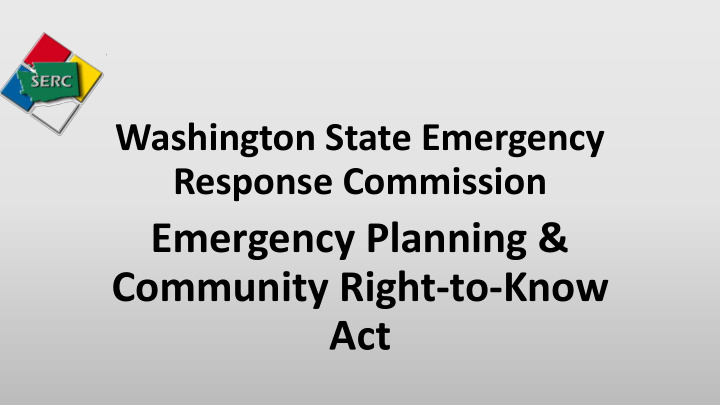



Washington State Emergency Response Commission Emergency Planning & Community Right-to-Know Act
Emergency Planning & Community Right-to-Know Act Why a new law? December 3, 1984
Emergency Planning & Community Right-to-Know Act Superfund Amendments and Reauthorization Act (SARA) 1986 Over thirty years ago, in 1986, President Reagan signed into law the Superfund Amendments and Reauthorization Act of 1986. SARA Title III is known as the Emergency Planning & Community Right-to-Know Act, most commonly called EPCRA. EPCRA was created for: • Emergency Planning • Preparedness and Training • Community Right-to-Know
Effect of EPCRA • The Governor of each state was required to appoint a State Emergency Response Commission (SERC) • The purpose of the SERC is to coordinate hazardous material issues and carry out the mandate of Public Law 99-499. The Commission is responsible for establishing a state hazardous materials emergency preparedness, response, and Community Right-to-Know program. • The SERC is the governing body that determines policy and reporting criteria for industries in our state.
Effect of EPCRA The Washington SERC was established on April 17, 1987 by an executive order from the Governor. SERC’s primary duties include: • Designation of LEPCs and oversight of their activities • Establishment of a state EPCRA program • Management of all notifications, reports, plans as required by EPCRA • Coordination with the EPA on EPCRA implementation • Appointment of ad hoc committees and working groups as required. • Review and evaluate local hazardous materials emergency response plans • Delegation of responsibilities between Ecology, WSP, and the Military Department in implementation of EPCRA in Washington.
Military Department Responsibilities • Administrative staff support for the SERC • Meeting information, correspondence, and written reports to SERC members, Tribes, and LEPCs • Receive and record verbal emergency release notifications • Provide assistance to LEPCs developing emergency response plans • Coordinate the review of each LEPC emergency response plan • Serve as repository for LEPC emergency response plans • Administer training, exercise, and planning grant applications on behalf of the SERC
Department of Ecology Responsibilities • Advise Commission on emergency spill response and environmental restoration issues • Advise on emergency responder equipment and training needs at state and local levels • Advise on environmental needs and on-scene spill response • Advise the Commission on Community Right-to-Know issues • Implement and maintain an EPCRA Program (Sections 302 – 313) • Liaison between the Commission and the EPA on Community Right-to-Know issues
Washington State Patrol Responsibilities • Advise the Commission on emergency response and coordination of on- scene activities on state and interstate highways • Provide advice on emergency responder equipment and training needs at state and local levels • Provide first responder training and maintain related records for state hazardous materials training. (EPCRA Section 305)
Local Emergency Planning Committees Each LEPC should include representation from: Elected local officials Local environmental Law enforcement Hospital Emergency management Transportation personnel Firefighting Media First Aid Community groups Health Profession Owners/operators of facilities that store extremely hazardous substances
Local Emergency Planning Committees Responsibilities • Report tracking • Hazard analysis • HazMat plans • Table top exercises • Full scale exercises • Public access
Industry Compliance Facilities must file one or all of these different types of reports depending on the type of business and the chemicals they store or release. • Section 302/303 - Extremely Hazardous Substances Notification • Section 304 - Emergency Release Notification/Written Follow up • Section 311 – MSDS/SDS submittal • Section 312 – Tier Two – Emergency & Hazardous Chemical Inventory • Section 313 – Toxics Release Inventory Report
State Emergency Response Commission Who is responsible for EPCRA enforcement? EPA and the public EPCRA Section 325 allows civil and administrative penalties ranging up to $10,000 - $75,000 per violation or per day per violation when facilities fail to comply with the reporting requirements. Potential penalties for facilities that fail to report in a timely manner are $37,500 per violation per day. EPCRA Section 326 allows citizens to initiate civil actions against EPA, SERCs, and the owner/operator of a facility for failure to meet the EPCRA requirements.
EPCRA Funding Did Congress provide funding when they enacted EPCRA? EPCRA is an unfunded mandate for states, tribes, and locals. Worker & Community Right-to-Know funds managed by Department of Labor & Industries. PHMSA’s Hazardous Materials Emergency Preparedness Grant: The Grant funds support WSP-managed training and LEPC projects. LEPCs dependent on grant opportunities to meet their responsibilities.
State Emergency Response Commission Accomplishments in past year • 5,000 businesses reported 18,703 chemicals stored at facilities throughout the state. • SERC Bylaws updated • The Tier Two reporting form was revised and databases were redesigned in response to EPA changes. • A mobile app was developed to give first responders quick access to chemical data. • WAEMD assisted LEPCs update their hazardous materials emergency response plans. • 2,300 first responders received over 24,000 hours of training. This training is supported by HMEP grant funds and helps to ensure that first responders meet both federal and state requirements.
State Emergency Response Commission current goals • Fill vacant positions on SERC • HMEP grants for EPCRA-related activities and training. • Update SERC Strategic Plan • Follow Executive Order 13650 – Improving Chemical Safety and Security and changes to chemical reporting requirements • Seek funding to support Statewide HazMat coverage
State Emergency Response Commission Fire Military Department of Washington Chief Department Ecology State Patrol Private Department of Department of Labor & Industries Transportation Industry Health Westside LEPC Eastside LEPC Transportation Local Emergency Representative Representative Industry Manager Local Emergency Planning Committee (LEPC)
State Emergency Response Commission QUESTIONS Chief Mike Harris SERC Vice-Chair Franklin County Fire District #3 mharris@fcfd3.org
Recommend
More recommend